|
I had submitted my thesis on "Overhauser effect Studies" at 3300G Magnetic Field Strength, in the year 1974. And, currently the DNP at High Fields is gaining importance for Sensitivity Enhancemnet and I had corresponded to be able to participate in the recently held DNP School on Enhanced NMR, but finally could not attend. The organizers have sent an EMAIL with Photographs (link: http://www.weizmann.ac.il/conferences/DNP/photos/gallery.html ) after the School and I thank the organizers with these few photographs in my website for the synopsis of my thesis. Aravamudhan... 7th December 2009 |
|
The DNP (of nuclei due to free radicals) with dominating scalar interaction mechanism can give positive enhancements while dipolar interaction results in negative enghancements. When both mechanisms are operating, then if Scalar interaction predominates the result would be a positive enhancement. The image above has a positively enhanced spectrum: the enhancements depend on the magnetic fields of the experiment. All the protons in a molecule undergoing quantitatively enhancements to the same extent can happen only if the free-radical interactions (scalar & dipolar) with every one of the protons is to the same extent independent of the topology of the molecule/differential D.N.P. effects, differing from one proton location to another proton location is usually observed. |
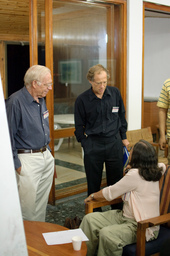
|

|
 Can we meet again? http://aravamudhan-s.ucoz.com/ CLICK HERE and JUMP to view a cartoon on D.N.P. |
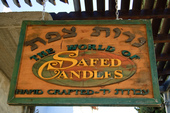
|
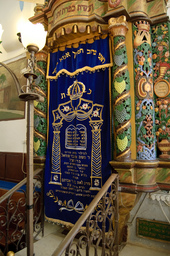
|
|
PROFESSOR P.T. NARASIMHAN 
|
In Partial Fulfillment of the Requirements for the Degree of
By
S.ARAVAMUDHAN
INDIAN INSTITUTE OF TECHNOLOGY, KANPUR
Synopsis of the Contents of Thesis
The thesis consists of six chapters. In Chapter I, a brief review of the recent Overhauser effect studies of "free radicals in solution" is given and the scope of the present work is also discussed.
Chapter II deals with the construction of an X-band Overhauser effect spectrometer for use at a magnetic field of 3300G in which a broad-band r.f. hybrid junction is employed for NMR detection. Due to difficulties in obtaining several associated equipments and components it has been necessary to make the fullest use of whatever equipment was available in our Institute for this study. Since a dual-purpose Varian EPR/ wide-line NMR spectrometer system was available we have built our Overhauser effect spectrometer around this unit.
A coil-in-the cavity arrangement is used for the Overhauser effect probe. The cavity is connected to a Varian V-4502 EPR spectrometer system, which constitutes the ESR part of the Overhauser effect set-up. A Varian VF-4210 variable frequency r.f. transmitter-receiver unit in conjunction with the V-4270B output unit and the associated sweep units are used in the NMR part. The original crossed-coil NMR probe has been replaced by a single coil system using the broad-band r.f. hybrid junction for the NMR detection. Field modulation at 20 Hz and field scanning are used to record the NMR spectra.
The mode of recording NMR spectra under Overhauser effect conditions, monitoring of microwave power and recording relaxation data are discussed in detail. It is pointed out here that the maximum microwave power available in our klystron was only 300 mW and the power reaching the sample cavity was even less. Nonetheless the enhancement factors extrapolated to infinite microwave power yielded U~ values in agreement with literature values for several proton containing_ systems. The effect of stimulated emission on these enhancement factors has been considered and it was found that under these experimental conditions the correction factors were within the experimental error. In Chapter III some results of Overhauser effect studies on protons in solutions of free radicals at room Chapter III some results of Overhauser effect studies on protons in solutions of free radicals at room m temperature are reported. These studies were made using the set-up described in Chapter II. Tri-tertiary butyl phenoxyl (TBP) radical has been used as the solute to observe the signal enhancement for protons of cyclohexane, o-, m-, and p-xylenes, n-pentane and n-hexane. These results have not been so far reported in the literature. In all these cases a dominant dipolar interaction has been noticed. U∞ values for these systems are reported. Results have been interpreted assuming a pure translation diffusion modulating the dipolar interaction.
The construction of an Overhauser effect spectrometer with higher NMR resolution capabilities at 3300 G is described in Chapter IV. The spectrometer described in chapter II does not have the capability to resolve chemically shifted NMR peaks. It was felt desirable to have a better resolving power NMR spectrometer for the Overhauser effect studies. A V-4311 fixed frequency (25.1 MHz) r.f. transmitter-receiver unit for 13C studies using the high resolution HA-100 NMR spectrometer was available to us. We therefore designed our new system incorporating this unit. The ESR part and the Overhauser effect probe are the same as in the earlier set-up described in Chapter II. The Varian V-4311 fixed frequency (25.1 MHz) unit has r.f. phase sensitive detection capabilities. The output of the r.f. phase-sensitive detector is available for recording or presenting on the Oscilloscope. But at 3300G the operating frequency of NMR for 1H is ~14 MHz. Moreover, slightly variable frequency for the NMR is required due to the variability of the ESR frequency depending on the nature of the solvents and free radicals. Since V-43l1 is only a fixed frequency unit at 25.1 MHz a mixing scheme with an external local oscillator has been adopted to suit the NMR frequency requirements. With this scheme it was possible to detect not only 1H resonance but 19F resonances also by altering the L.O. frequency appropriately. A set of homogeneity coils mounted on the magnet pole faces were used to improve the magnetic field homogeneity at the sample. With this set-up we could achieve a moderate resolution for protons, which are chemically, shifted by ~ 10 Hz even without sample spinning. A field-frequency lock system suitable for incorporation in this spectrometer has also been constructed and tested. The sensitivity and performance of this set-up was significantly superior to our earlier set-up.
In Chapter V some of the results of our Overhauser effect studies at room temperature under moderate resolution conditions are reported. Some of the systems which have been studied using the earlier set-up have been reinvestigated with the new spectrometer and good agreement for U∞ values was obtained. The studies on 0-, m- and p-xylenes show that the signal enhancement factors for the methyl protons and the ring protons are nearly equal. Studies made on mixtures of some proton containing solvents with TBP radical show that for these systems the variation in enhancement factors can be understood on the basis of the changes in the viscosity of the medium. Enhancement of the t-butyl protons of tri-tertiary butyl phenol could be observed when tritertiary butyl phenol was dissolved in carbon tetra chloride and a small fraction of this was reduced to tritertiary butyl phenoxyl radical. The interaction in this case has been reported earlier to be of the scalar type and this could be confirmed. 19F resonance could be observed using this set-up by changing the L.O. frequency. 1, 2, 2-Trifluoro trichloro ethane showed two chemically shifted 19F peaks in the intensity ratio 1:2. When Overhauser effect studies were carried out on this solvent with TBP radical as the solute a dominant dipolar interaction was observed for both the peaks. The two peaks, however, enhanced to different extents. This has been attributed to the differences in the scalar interaction between the solvent 19F nuclei and TBP radical due to the presence of different number of chlorine atoms in the neighborhood of the two types of 19F nuclei. A model based on molecular orbital theory has been discussed in Chapter V to explain the trends observed in 1,2,2- Trifluoro trichloro ethane. In the last chapter of this thesis suggestions are made for further possible improvement of the present Overhauser effect spectrometer system.
Table of Contents
|
|
page |
||
|
CERTIFICATE I |
|
ii |
|
|
CERTIFICATE II |
|
iii |
|
|
STATEMENT |
|
iv |
|
|
PREFACE |
|
v |
|
|
ACKNOWLEDGEMENTS |
|
vii |
|
|
CHAPTER I |
INTRODUCTION |
||
|
I.1 |
General |
1 |
|
|
I.2 |
Electron-Nuclear Interaction |
2 |
|
|
I.3 |
Correlation Function, Spectral Density and Relaxation Transition Probabilities |
6 |
|
|
I.4 |
Origin of DNP and the Relevant Parameters |
10 |
|
|
I.5 |
Experimental Determination of Relevant Parameters |
15 |
|
|
I.6 |
Models for the Calculation of |
19 |
|
|
I.6.1 |
Models for Dipole-Dipole Interaction |
23 |
|
|
I.6.2 |
Models for Mixed Scalar and Dipolar Interaction |
28 |
|
|
I.6.3 |
Use of the Theoretical Models in the Analysis of Data Obtained from DNP and Other Relevant Measurements |
35 |
|
|
I.7 |
Experimental Techniques |
40 |
|
|
I.8 |
A Survey of Experimental Results |
48 |
|
|
I.8.1 |
Studies on Protons |
48 |
|
|
I.8.2 |
Studies on 19F Nuclei |
55 |
|
|
I.8.3 |
Studies on 3lp Nuclei |
60 |
|
|
I.8.4 |
Studies 'on 13c Nuclei |
64 |
|
|
I.8.5 |
Studies on other Nuclei |
68 |
|
|
I.9 |
Scope of the Present Work |
69 |
|
|
|
References |
75 |
|
|
CHAPTER II |
CONSTRUCTION OF' AN X-BAND OVERHAUSER EFFECT SPECTROMETER USING AN RF INBRID JUNCTION FOR NMR DETECTION |
||
|
II.1 |
Introduction |
80 |
|
|
II.2 |
The Overhauser Effect Probe |
87 |
|
|
II.3 |
R.F. Hybrid junction for NMR Detection |
91 |
|
|
II.4 |
The NMR Spectrometer |
94 |
|
|
II.5 |
Relaxation measurements |
97 |
|
|
II.6 |
Microwave Power measurements |
97 |
|
|
II.7 |
Performance Evaluation of the Set-up |
101 |
|
|
II.8 |
Concluding remarks |
106 |
|
|
|
References |
108 |
|
|
CHAPTER III |
RESULTS OF OVERHAUSER EFFECT STUDIES ON SOME PROTON--CONTAINING SOLVENTS WITH TBP |
||
|
III.1 |
Introduction |
109 |
|
|
III.2 |
Theory and the Method of calculation of Distance of Closest Approach |
110 |
|
|
III.3 |
Experimental |
113 |
|
|
III.4 |
Results and Discussion |
114 |
|
|
III.5 |
Concluding Remarks |
122 |
|
|
|
References |
123 |
|
|
CHAPTER IV |
CONSTRUCTION OF AN X-BAND OVERHAUSER SPECTROMETER WITH MODERATE NMR RESOLUTION CAPABILITY |
||
|
IV.1 |
Introduction |
124 |
|
|
IV.2 |
The Varian V-4311 R.F. Unit |
125 |
|
|
IV.3 |
A Description of the Overall Set-up |
126 |
|
|
IV.4 |
Some Details of the Mixers and R.F. Amplifiers Employed in this set-up |
129 |
|
|
IV.5 |
The Local Oscillator |
135 |
|
|
IV.6 |
NMR Field Sweep |
136 |
|
|
IV. 7 |
NMR Stabilization of the Magnetic Field |
138 |
|
|
|
References |
145 |
|
|
CHAPTER V |
SOME RESULTS OF OVERHAUSER EFFECT STUDIES ON 1H AND19F NUCLEI UNDER MODERATE NMR RESOLUTION CONDITIONS AT 3300G |
||
|
V.l |
Introduction |
146 |
|
|
V.2 |
Studies on 1H Nucleus |
147 |
|
|
V.2.1 |
Xylenes with TBP |
147 |
|
|
V.2.2 |
Mixtures of Solvents with TBP |
150 |
|
|
V.2.3 |
Tritertiarybutylphenol with TBP |
155 |
|
|
V.3 |
Studies on 19F Nucleus |
156 |
|
|
V.3.1 |
Experimental Studies on l, 2, 2-Trifluorotrichloroethane |
156 |
|
|
V.3.2 |
A Molecular Orbital Treatment of Spin Density Perturbations in l, 2, 2-Trifluorotrichloroethane due to TBP |
158 |
|
|
|
References |
174 |
|
|
CHAPTER VI |
SUGGESTIONS FOR FURTHER IMPROVEMENT IN THE PRESENT OVERHAUSER EFFECT SPECTROMETER |
||
|
VI.1 |
Introduction |
175 |
|
|
VI.2 |
ESR Part |
175 |
|
|
VI.3 |
Overhauser Effect Probe |
176 |
|
|
VI.4 |
NMR Part |
177 |
|
|
VI.5 |
Concluding Remarks |
178 |
|
|
|
References - |
180 |
|
|
VITAE
|
|||
Below displayed are scanned images of photographs from thesis
depicting the Instrument and Measurements
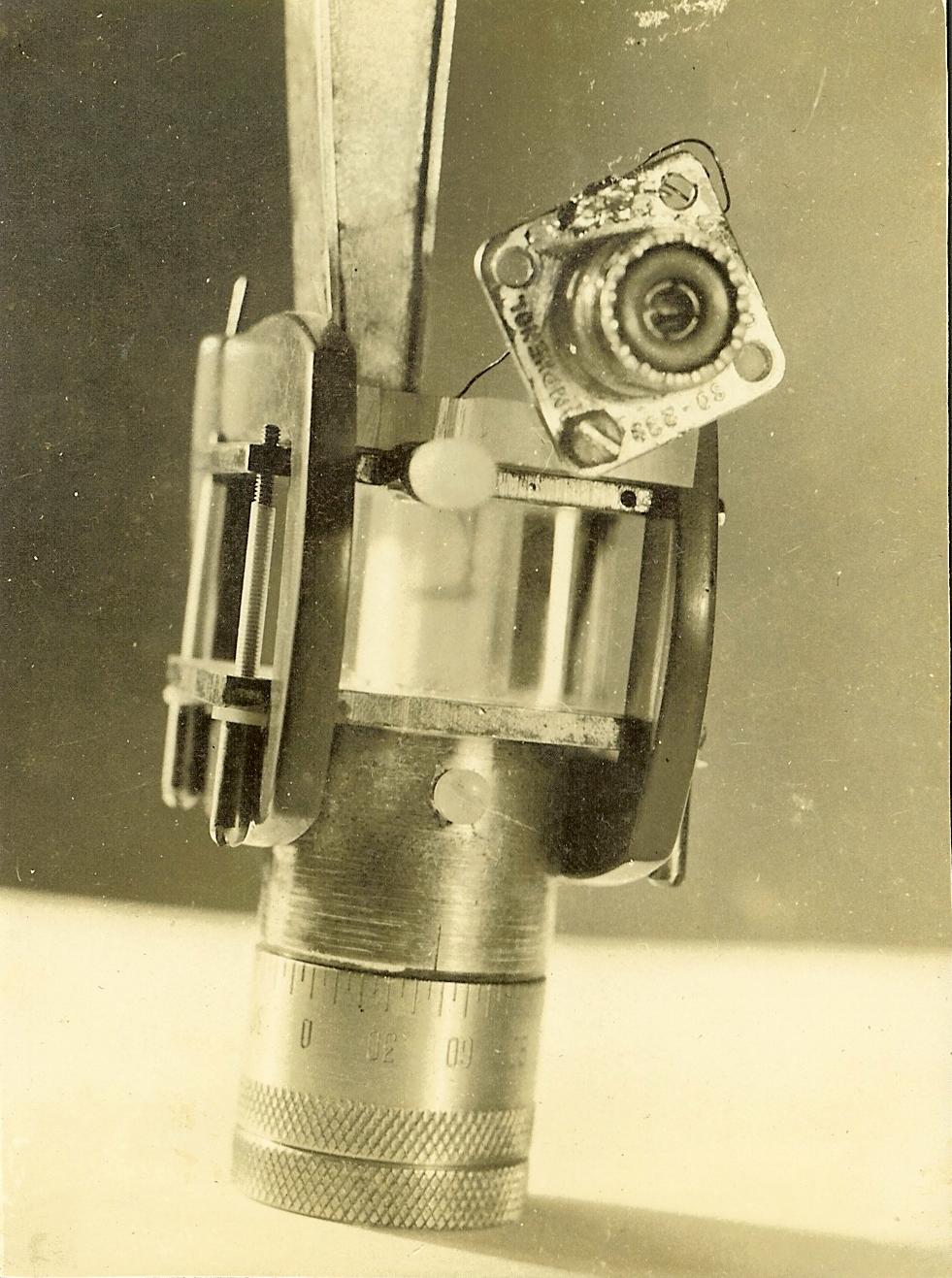 NMR-Coil in ESR-Cavity ( Chapter-II Fig.II.4 )
|
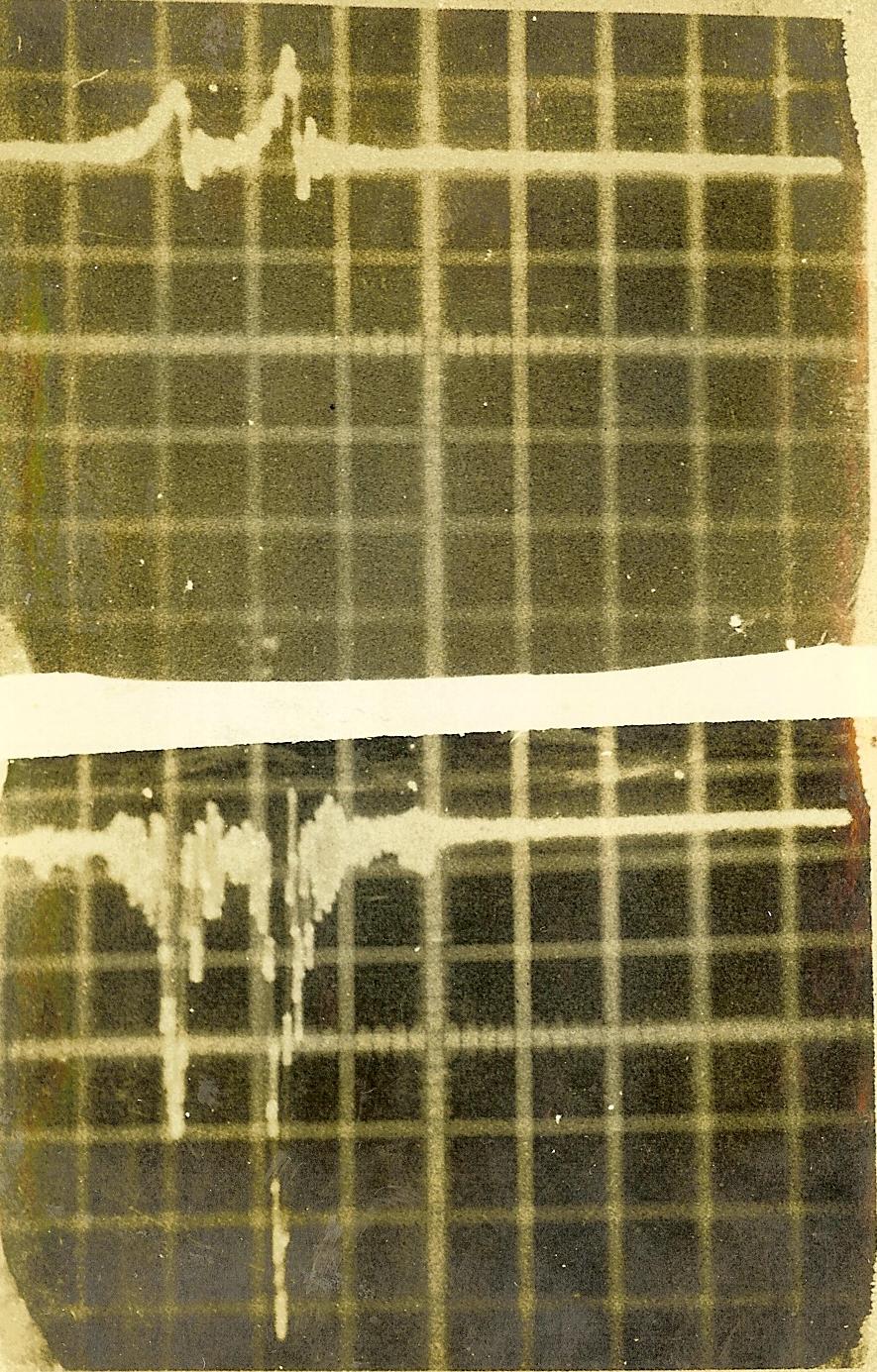 Overhauser enhancements (Chapter-IV Fig.IV.3) upper: Unenhanced lower: Negatively enhanced
|
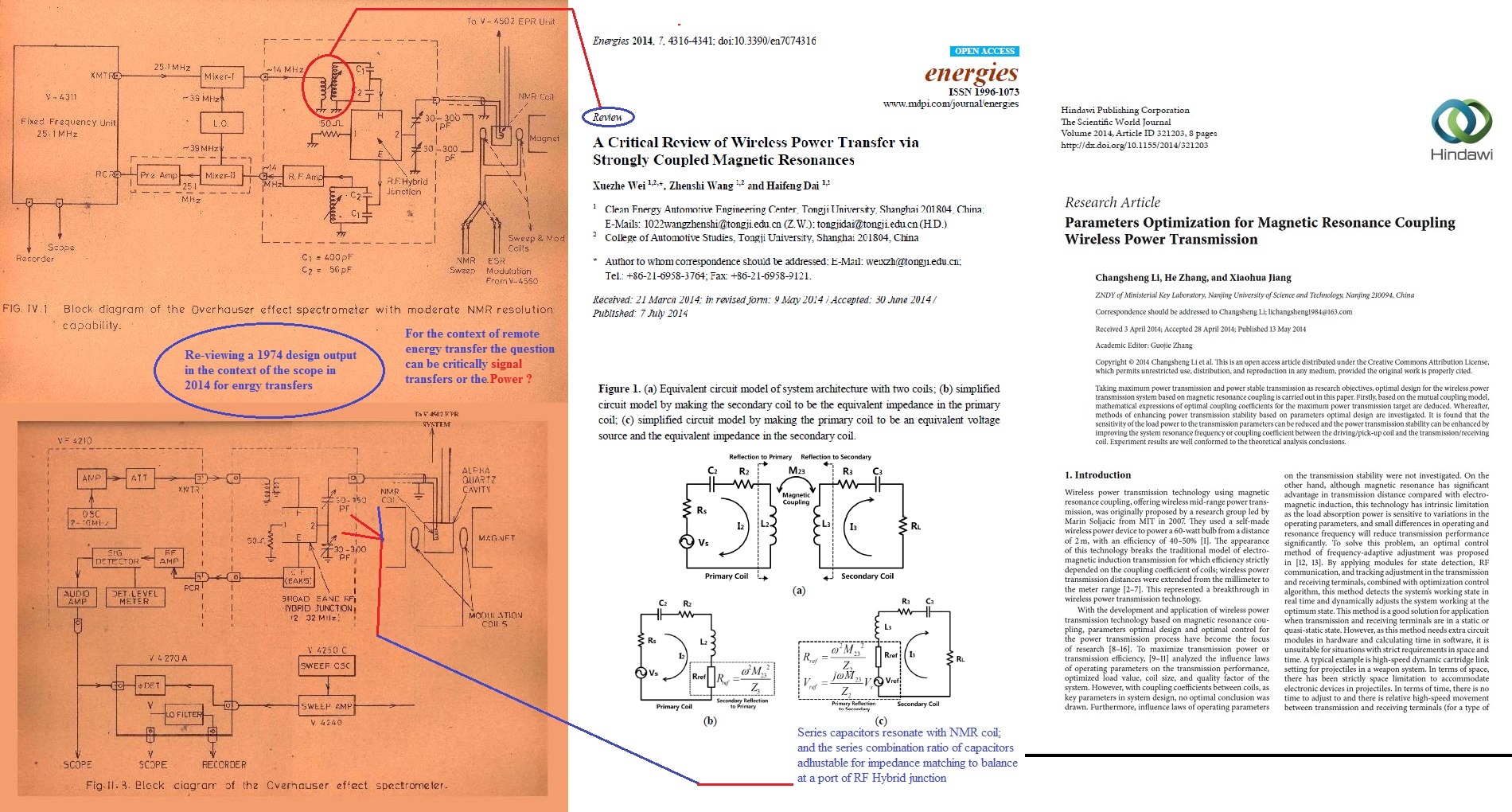 link for the original full paper on energies (in figure above) in pdf format (from internet resources):sa-thesis-design-energies-07-04316.pdf link for the original full paper on Wireless Power Transfer(in figure above) in pdf format (from internet resources):WirelessPower-321203.pdf |
|
|
ISMAR-CA98;Link1 ISMAR-CA98;Link2 ISMAR-2013 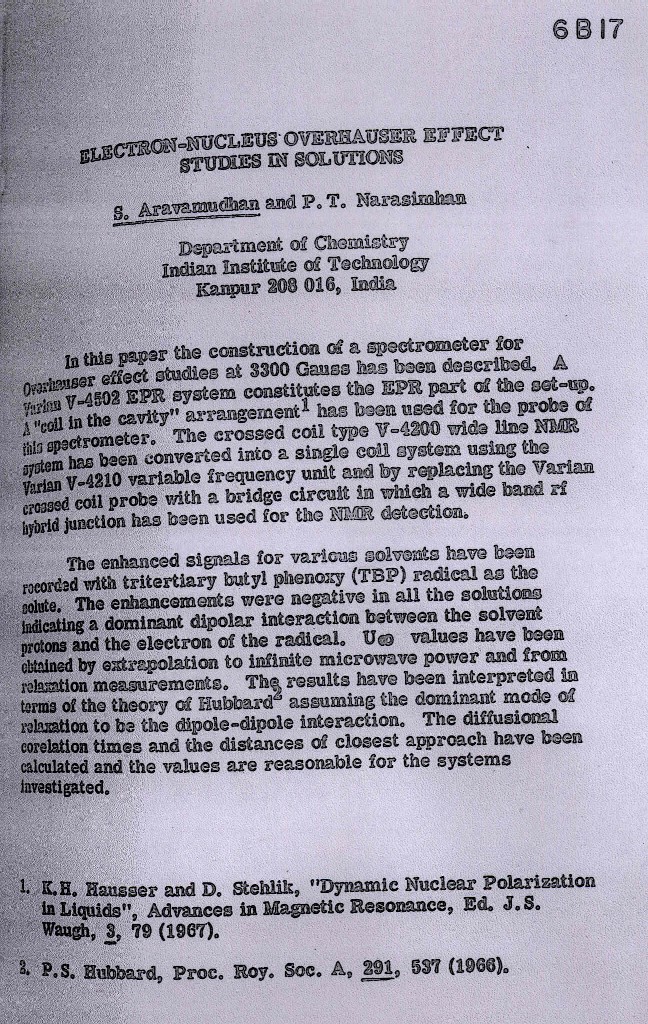 The Scanned (at Biochem,NEHU) Image of the Abstract for the oral presentation (by S.Aravamudhan) at the Internatioanl Conference of ISMAR held at T.I.F.R. Mumbai in Jan. 1974 CLICK HERE to download a publication illustrating the current APPLICATION of the BLOCK SIEGERT SHIFT in Magnetic Resonance.The SUBJECT of the Cartoon----> on the right hand side column is this "Block Siegert Effect"----> CLICK HERE to JUMP to TOP of Page |
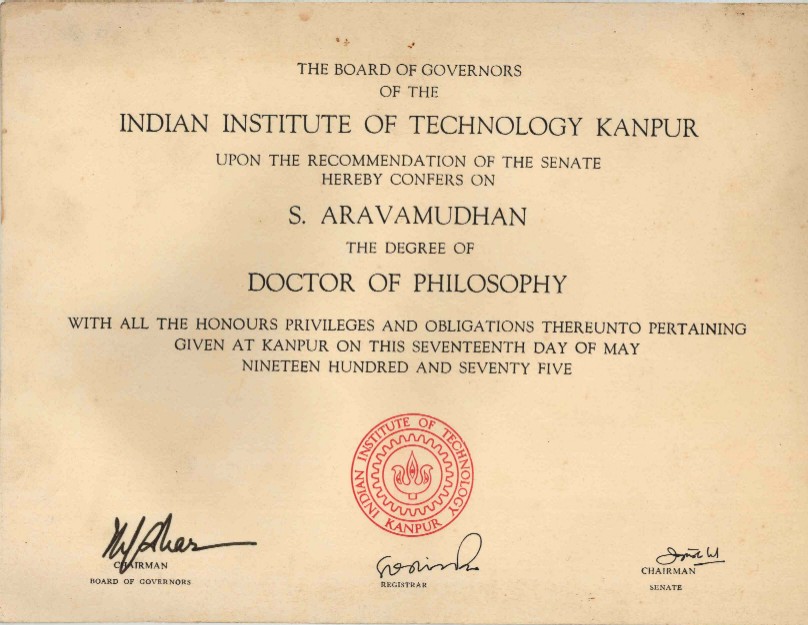 The Scanned (at Biochem,NEHU) Image of the Ph.D., Degree Certificate 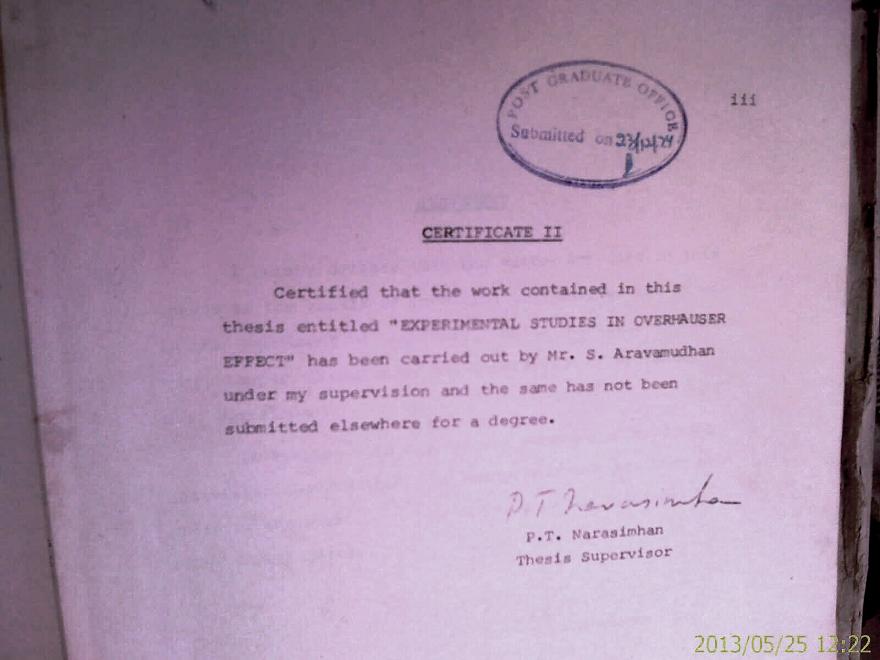 The Certificate by Ph.D.Superviser Prof.P.T.Narasimhan Photo image from the thesis bound volume The CARTOON below was drawn and furnished on 18th Feb.2012 by Dr.Aravamudhan at Chennai after the 99th ISC / events_2012 CLICK HERE to JUMP to TOP of Page |